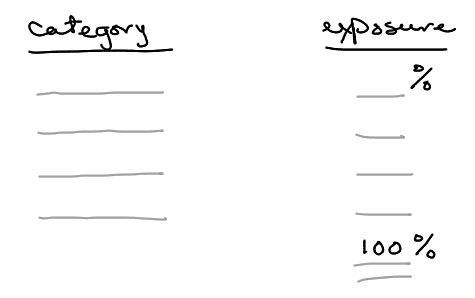
- Thursday, July 29th, 2010
- conceptual categories
-
How do you organize your thinking about investments? At a basic level, most people consider their holdings in a fashion like this:
 So, what are your categories? How long have you had them?
So, what are your categories? How long have you had them?Maybe they are asset classes or sectors or industries or themes or tax-impact buckets or some combination thereof. Maybe you have an advanced system whereby the exposures of packaged products like funds are disaggregated into the proper line items. Maybe the economic impact of the optionality of various instruments is factored in and maybe you have even moved on to the next generation of risk classifications before everyone else. Or maybe your construct is as simple as could be imagined.
In any case, at the root of your approach is a series of conceptual categories that you use to think about the world. Where did they come from?
This is not idle musing. It is helpful to know how they originated and even more important to figure out whether they are still valid. Our tendency is to keep shoving our exposures into the same dated categories, even after the world has changed.
An analogy can be drawn to the folders on a computer or in a file cabinet. Sometimes you just have to wonder what you were thinking when you set up the filing system in the way that you did. But, rather than redoing the structure, you live with it and adapt to it, knowing that it might not be the greatest, but it’s good enough for now.
Something very similar happens in the investment world. You even see it at asset management firms, where it’s possible to do the equivalent of carbon dating: By looking at the reporting structure being used, you can tell when the code that runs it was written. The degree to which a codification scheme is out of date is especially obvious during periods of rapid change. The fixed income market of the last thirty years is a perfect example. You can see from a glance at a firm’s reports when the last conceptual change in categorization occurred.
Investment policies are the same way. If you look at one for a pension plan or foundation, you’ll see that the range of investments allowed or prohibited follows some agreed-upon approach to thinking about the markets. That approach tends to lag the evolution of the markets, and given the nature of organizations and the quite infrequent reviews of allocation policy, the policies often lag badly.
If your way of thinking about your investment exposures is out of sync with the reality of today, it’s time to rip it up and start over. That also means that you need to examine whether the tools that you use and the information you get from market data vendors need to be adjusted or abandoned. Your ideas and your methods need to go hand in hand, and must reflect the world of today. Like it or not, it’s not 1985 any more.
